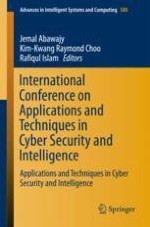2018 | Buch
International Conference on Applications and Techniques in Cyber Security and Intelligence
Applications and Techniques in Cyber Security and Intelligence
herausgegeben von: Prof. Jemal Abawajy, Kim-Kwang Raymond Choo, Dr. Rafiqul Islam
Verlag: Springer International Publishing
Buchreihe : Advances in Intelligent Systems and Computing
